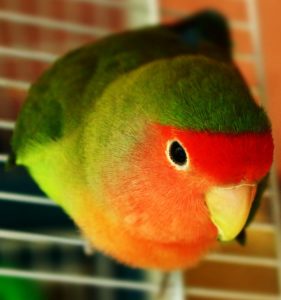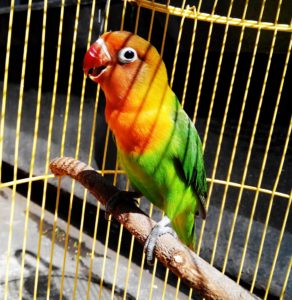8 Lovely Facts About Lovebirds

Happy Valentine’s Day everyone! Chances are you are headed towards a diabetic coma induced by the many chocolates bestowed on you from your sweetheart. With sweets in the belly and love on your mind you may get to thinking about how the holiday came to be associated with romantic love. A little bird told me that it all started with a poem by Chaucer called “Parliament of Foules,” where it depicts the affections of two, not so figurative, Lovebirds. This is the first known record of Valentine’s Day taking on meaning outside of a strictly religious holiday.
In keeping with the spirit of the St. Valentine, here are eight fun facts about lovebirds that would make even the Lady and the Tramp blush!
- Much in the style of the adored aforementioned couple, lovebirds will frequently feed each other to maintain a strong affectionate bond. This will occur most frequently when one of the pair is distressed or after a long separation (which tends to cause distress). And this is because…
- Lovebirds will start behaving erratically and become sullen if separated from their mate. Their behavior is known to be similar to depression in humans and they have also been reported to die from “Heartbreak Syndrome.” Lovebirds have high levels of oxytocin in their brains (also
 known as the love hormone). This means that the bonds they create are deep and meaningful. Due to the intensity of the bond they develop with their mates they are one of the few animals on earth who mate for life. This results in great distress when kept apart and is also the reason for the bird’s fitting name. Domestic lovebirds do best in pairs, although this is not necessary if you are willing to dedicate a little more time to them to ensure they do not become lonely. Many lovebirds have lived long happy lives with only their human companions.
known as the love hormone). This means that the bonds they create are deep and meaningful. Due to the intensity of the bond they develop with their mates they are one of the few animals on earth who mate for life. This results in great distress when kept apart and is also the reason for the bird’s fitting name. Domestic lovebirds do best in pairs, although this is not necessary if you are willing to dedicate a little more time to them to ensure they do not become lonely. Many lovebirds have lived long happy lives with only their human companions. - Another thing you may not have known about lovebirds is that there are more than one type to choose from. Specifically, there are nine species that are classified as lovebirds, but only three types are kept as pets. Hailing from Africa the first appearance of these feathered Casanovas can be dated back nearly two million years. Today they can be found in the wild on several continents, including both Americas.
- Lovebirds are the fourth most popular companion bird in the United States.
- Like any love-crazed buffoon lovebirds are extremely playful. When left to their own devices in a cage they will oftentimes amuse themselves and their ates by humping around and hanging from any object that will support their weight. Due to their high activity levels, it is recommended that they have a large area to spread their wings, so to speak, or are able to get some much needed time out of their cages. They also have high intelligence levels, so it is important to give them toys and puzzles so they don’t get bored. Their high intelligence can also make them
 impressive escape artists.
impressive escape artists. - Though they are considered a type of parrot you won’t catch them whispering sweet nothings. Lovebirds are not among the type of parrots that speak, if they do choose to mimic a sound it will most likely be a simple noise like whistling or doorbells. In the parrot family love birds are the smallest, though clearly their big hearts make up for their small stature.
- Lovebirds usually build their nests in the hollows of trees, or more commonly for the peach-faced lovebird, in cactuses. If you are keeping one in your home it is important to equip them with a safe little place to sleep like a tent or similar snuggly locations.
- Seven out of the nine species of lovebirds are androgynous, meaning you can’t tell the males apart from the females. In two species the genders can be distinguished by color and size, but for the majority of them the males and females both have bright indistinguishable plumage to attract mates and participate in similar attraction rituals, including putting nesting materials in their feathers to show their mate that they can build a good home. The relationship they have with one another is truly one of equals.
What are some unusual facts about lovebirds you have heard? Would you ever adopt a pair of lovebirds as pets? Leave a comment and let us know!
